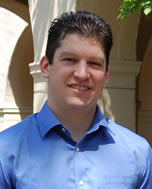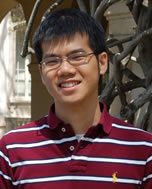 Mr. Vermesh, a graduate student in Chemistry working with Professor Jim Heath, has led an effort to develop a microfluidics chip designed to take a fingerprick of blood, separate the plasma from the whole blood, and then assay for a large panel of blood-based protein biomarkers, using a barcode-like format, all within a few minute time period. This microchip, called the Integrated Blood Barcode Chip (IBBC), has the potential to completely change how clinical-based blood protein biomarkers are measured (See video of Ophir Vermesh presenting the Integrated Blood Barcode Chip (IBBC)). As a measurement of the value of the IBBC, it is already being utilized in three different human trials, including a brain cancer trial that involves oncologists at UCLA. Mr. Vermesh, a graduate student in Chemistry working with Professor Jim Heath, has led an effort to develop a microfluidics chip designed to take a fingerprick of blood, separate the plasma from the whole blood, and then assay for a large panel of blood-based protein biomarkers, using a barcode-like format, all within a few minute time period. This microchip, called the Integrated Blood Barcode Chip (IBBC), has the potential to completely change how clinical-based blood protein biomarkers are measured (See video of Ophir Vermesh presenting the Integrated Blood Barcode Chip (IBBC)). As a measurement of the value of the IBBC, it is already being utilized in three different human trials, including a brain cancer trial that involves oncologists at UCLA.
Vermesh came to think about using blood as a common route to routinely monitor health and disease by tracking the levels of a large panel of plasma proteins. However, blood is a complex biological fluid containing large numbers of blood cells and huge numbers of blood proteins that make up the highly complicated human proteome. In addition, plasma proteins begin to degrade or change within five minutes of blood sampling. Thus, the blood-testing device he set out to invent had to accomplish the separation of plasma from whole blood and finish measuring all plasma proteins of interest in minutes.
The first step was to remove blood cells from whole blood. Recalling and taking advantage of the Zweifach-Fung effect, he designed and fabricated a blood separation module in a plastics-based microfluidic device. This module features a main channel that mimics a short-cut capillary, while multiple long channels branch off perpendicularly to mimic high-flow resistance capillaries. As whole blood is flowed into the main channel, all blood cells are directed downstream from the main channel, while a certain amount of pure plasma is skimmed into the branch channels and collects in the assay chamber. Vermesh also performed careful network modeling to optimize the flow resistance and plasma separation efficiency. Finally, a high-density antibody microarray was cleverly placed in the region of the branch channels, such that the plasma proteins can be measured right away without any additional off-chip processes. All this together made it possible to rapidly measure a large number of disease-related plasma proteins from small amounts of whole blood (e.g. a finger prick) before the protein profile begins to change.
Using this device, Vermesh first demonstrated the successful measurement of a dozen immune signaling proteins, liver-toxicity proteins, and cancer markers spiked into his own blood. Later, the sera from 22 cancer patients were measured, and the results amazingly revealed the existence of potential cancer subtypes characterized by their unique cancer-immune interactions. As many human diseases, including cancer, are so heterogeneous, the pathogenic mutation pattern differs from patient to patient. This device demonstrates the potential for stratifying patients, enabling personalized treatments.
Because the integrated blood chip requires very low reagent volumes and hundreds of assays can be packed into a very small space, the cost per protein assayed could fall from $50 to just 5 cents. Already, a portable next-generation version of this chip has been developed that is completely powered internally, such that no external hardware (gas cylinders, tubing, etc) is required to push fluid through the device. |
 Mr. Chueh, a graduate student in Materials Science working with Professor Sossina Haile, has developed a method for heating and cooling cerium dioxide with the effect of splitting water into oxygen and hydrogen; the process can be readily extended to that of splitting carbon dioxide into carbon monoxide and oxygen, or the simultaneous reaction of carbon dioxide and water to create a combination of carbon monoxide and hydrogen, a fuel mixture known as syngas. Mr. Chueh, a graduate student in Materials Science working with Professor Sossina Haile, has developed a method for heating and cooling cerium dioxide with the effect of splitting water into oxygen and hydrogen; the process can be readily extended to that of splitting carbon dioxide into carbon monoxide and oxygen, or the simultaneous reaction of carbon dioxide and water to create a combination of carbon monoxide and hydrogen, a fuel mixture known as syngas.
Chueh has transformed what was at first a loosely conceived idea into a technologically relevant hydrogen production process. He carefully designed and performed experiments to demonstrate fine tunability of the CO to H2 ratio in syngas generation. Syngas is a key input for the synthesis of a range of chemical compounds, with different compounds requiring different CO to H2 ratios, and hence demonstrating tunability is much more than a scientific achievement.
Chueh then took the process one step further and showed that by including a common base-metal catalyst, nickel, he could in situ convert the syngas to methane. The significance of this cannot be overstated. In today's energy infrastructure, the intermittency of solar (and wind) energy sources requires that renewable energy power plants be co-cited with natural gas 'peaker' plants which can be quickly ramped up and down to follow demand when the renewable resource does not. If one can produce natural gas (methane) using excess solar energy during the daylight hours, burn this fuel during the night-time hours, and use the exhaust as input for subsequent methane production, then one has a way of expanding the reach of renewable energy such that it can become a meaningful part of our energy mix. In short, Chueh has developed a method to produce fuel (e.g. methane) directly from heat. By using the heat from the sun directly and avoiding the inefficient electrolysis steps needed to produce a fuel to store solar-produced electrical energy, this ceria-based system could have enormous technological implications as it could produce carbon-neutral fuel directly from solar energy.
Chueh's successful demonstrations of the method, as well has his ability to clearly describe the process and the remaining challenges have been instrumental in convincing eSolar, a company dedicated to making renewable energy cost-competitive with fossil fuel energy, to construct the solar concentrator required to provide the solar-thermal energy for the fuel production process. |
